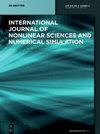Computational study of intravenous magnetic drug targeting using implanted magnetizable stent
IF 1.5
4区 工程技术
Q2 ENGINEERING, MULTIDISCIPLINARY
International Journal of Nonlinear Sciences and Numerical Simulation
Pub Date : 2022-10-10
DOI:10.1515/ijnsns-2019-0200
引用次数: 0
Abstract
Abstract Magnetic carriers for guiding, delivery, and capturing of drugs to desired place attract interest in the field of smart treatment of various pathological conditions. Presented paper, therefore, deals with one such application with the theoretical model of magnetic fluid flow through vessel bifurcation with one arm treated with ferromagnetic vascular stent placed in an external originally homogeneous magnetic field. This flow was described as laminar Newtonian incompressible continuum of the magnetic many-bead system, with Reynolds number ≈ 1 $\approx 1$ , using magnetic force variant of the Nernst–Planck equation coupled with the Navier–Stokes equations, solved numerically by the finite element method (FEM). This approach allowed us to quantify capturing efficiency of magnetic beads in each arm of bifurcation vessels. Results show reduction of the number of magnetic beads entering as well as leaving the arm treated with stent in comparison with the untreated one. For stented bifurcation arm, the significant amount of beads are captured to its luminal surface, which may be used for drug delivery using magnetic carriers.植入磁化支架静脉磁性药物靶向的计算研究
磁性载体用于引导、递送和捕获药物到所需位置,在各种病理条件的智能治疗领域引起了人们的兴趣。因此,本文讨论了一个这样的应用,即磁性流体通过血管分叉的理论模型,其中一只手臂被放置在原本均匀的外部磁场中的铁磁性血管支架处理。利用磁力型的Nernst-Planck方程与Navier-Stokes方程耦合,用有限元法对该流进行数值求解,将其描述为雷诺数≈1$ \近似1$的磁性多磁头系统的层流牛顿不可压缩连续体。这种方法使我们能够量化磁珠在分岔血管的每个臂中的捕获效率。结果显示,与未接受支架治疗的手臂相比,接受支架治疗的手臂进入和离开的磁珠数量减少。对于支架分叉臂,大量的微珠被捕获到其管腔表面,这可能用于使用磁性载体给药。
本文章由计算机程序翻译,如有差异,请以英文原文为准。
求助全文
约1分钟内获得全文
求助全文
来源期刊
CiteScore
2.80
自引率
6.70%
发文量
117
审稿时长
13.7 months
期刊介绍:
The International Journal of Nonlinear Sciences and Numerical Simulation publishes original papers on all subjects relevant to nonlinear sciences and numerical simulation. The journal is directed at Researchers in Nonlinear Sciences, Engineers, and Computational Scientists, Economists, and others, who either study the nature of nonlinear problems or conduct numerical simulations of nonlinear problems.

 求助内容:
求助内容: 应助结果提醒方式:
应助结果提醒方式:


